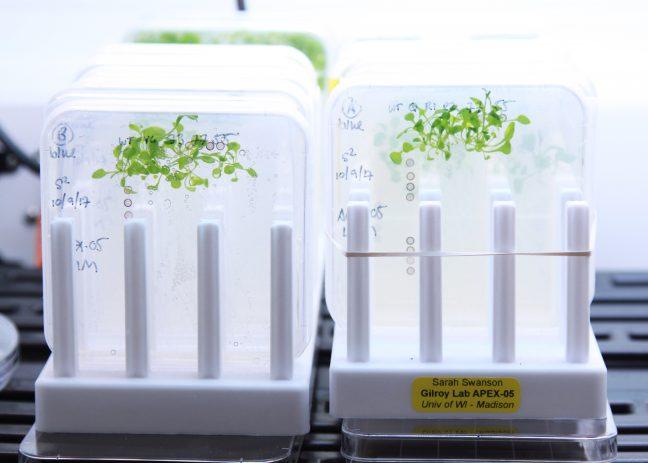After developing the first ever astrobotany website, Kai Nakano Rasmussen’s next big plans are to market his scientific research with an astrobotany streetwear clothing line.
Rasmussen is a University of Wisconsin senior and undergraduate researcher who works in the Gilroy Lab on a NASA-funded research project studying the effects of spaceflight on plant biology.
His lab tenure began in spring 2015, but since then, his more recent projects have evolved to include more of his artistic interests such as developing a rap song, website and now, a science-themed clothing line.
The website helps Rasmussen communicate his scientific research more broadly, however, it is not the only method he uses to tell the story of astrobotany, the study of plants in space.
“Astrobotany.com is just a piece of a loftier goal to make science education and research more integrated and more accessible,” Rasmussen said. “[This website] is a platform we use to inform not only the public, but also researchers, and hopefully help science move forward faster.”
Rasmussen said he started drawing at an early age, influenced from American cartoons and Japanese animation, but he has always gravitated toward science because of the impacts it has on society.
While he doesn’t necessarily want to understand the microscopic details of biochemical mechanisms, Rasmussen said he does recognize importance of a scientific education for his artwork.
“Really to be a science artist you should have [a scientific] background because you can’t really draw if you don’t know what you’re talking about,” Rasmussen said.
All of his past efforts have set him up to develop “COSMOS,” his new clothing line that is meant to connect scientific research, flowers, spaceflight, and art. He launched the commercial line after winning a runner-up prize of $500 at the New Arts Venture Challenge last spring.
Rasmussen saw streetwear clothing as a unique branding opportunity for astrobotany and a way to engage his newest passion — fashion designer work. His biggest concern, though, was whether a brand focused on science themes can break into a market where science hasn’t traditionally been seen as “cool.”
Rasmussen said the clothing line isn’t the only new product to come out of the Gilroy lab as advancements in research have provided more material for his website.
The Gilroy Lab is now launching a new experiment at the Kennedy Space Center, where they plan to continue their research on the effects of spaceflight on the growth of Arabidopsis thaliana, the model plant for scientific research.
In partnership with NASA and SpaceX, the lab is scheduled to launch more plants early December on the next commercial resupply service mission from SpaceX.
Advancements in research techniques, like RNA sequencing, have brought other Gilroy Lab members like Richard Barker, a postdoctoral research associate, to make contributions to the website.
Barker was one of the designers for a database named Test Of Arabidopsis Space Transcriptome as a resource for spaceflight plant biology researchers to quickly locate specific genes in the A. thaliana genome.
Sarah Swansen, director of the Newcomb Imaging Center, said Rasmussen’s efforts have been “overwhelmingly positive” for astrobotany as a research subject and science communication overall.
“I want to support [Rasmussen] because engaging the public is so important in helping the regular Joe on the street to understand what we’re doing, and why it’s important and why his tax money should go toward supporting our scientific efforts,” Swanson said.
The website gained more views after the recent 2017 American Society for Gravitational Space Research Conference, where Barker was able share the website among others within the astrobotany research community.
As Rasmussen’s website continued to gain more notoriety, he said a redesign was necessary to make the site accessible to both researchers and the general public. It’s more of an issue for people to not know what astrobotany is than for people to misunderstand the facts of it.
“The reason why science isn’t accessible is because it’s so rigid,” Rasmussen said. “There’s not a lot of room for personal interpretation.”
Rasmussen said he believes scientists and science communicators need to be honest about the hard work involved in the scientific method if they want to connect with the public.
Ultimately, Rasmussen thinks scientists need to use alternative methods like fashion and rap music to successfully and effectively communicate science to a general audience.
“I know the kids that aren’t interested in [science], and their language isn’t sitting down and reading a paper or listening to the NASA podcast,” Rasmussen said. “I’m trying to reach out to people that aren’t already interested and show them they can be included in science too.”


